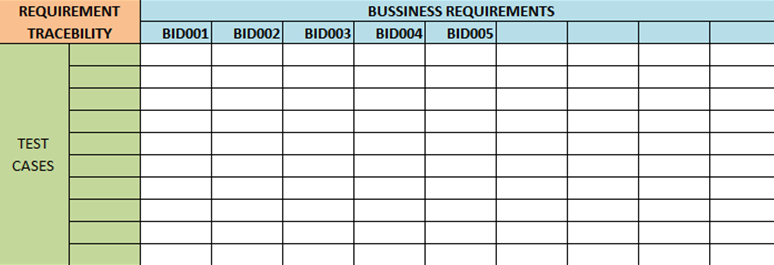
Introduction to Requirement Traceability Matrix
Project completion is a challenge for every firm, and each project has a different requirement and approach; one can complete a project on time when every requirement is properly analyzed. So to make the project completion easy and to fulfill all the requirements, we use RTM (Requirement Traceability Matrix). An RTM is a document or table that links requirements throughout the validation process. The purpose of the Requirements Traceability Matrix is to ensure that all requirements defined for a system are tested in the life cycle.
Definition of Requirement Traceability Matrix
Requirement Traceability Matrix, usually called RTM, is a document or a table that is enlisted with the clients’ requirements for the project in work. This is a simple type of matrix with a row and column structure that clearly defines which requirement is fulfilled and which is changed in between the process. So in the whole RTM, we trace the test cases regarding the client’s requirement and view the defects in the requirement during the process.
Why is Requirement Traceability Matrix Required?
There are a number of benefits of RTM, this is used to trace the clients’ requirements, and we can also find the defects in the requirement if any. Apart from that, RTM provides the quality to the project as different defects are removed by this, and also, if there is any change in the requirement in between the test, we can easily alter this and save time and energy. These things help a lot to complete the project in time and in a faster manner.
Types of Requirement Traceability Matrix
Given below are the different types of Traceability Matrix:
1. Forward Traceability
The forward traceability is the type of traceability matrix; it will help the manager analyze and assure that the project is going smoothly in the right direction. All the requirements that the client provides are tested.
2. Backward Traceability
This is another type of matrix that assures the manager that the project’s scope is not enlarged or the requirement which is there is strictly followed without adding extra cases or features that may not be part of the project.
3. Bidi Sectional Traceability
This traceability type helps the manager map the requirements to test cases for both the forward and backward traceability in a single document. So this type ensures that all the requirements are tested properly.
Examples of Requirement Traceability Matrix
Below are examples of the Requirement Traceability Matrix.
|
Business Requirement No |
Description |
|
BR1 |
Some business requirements got from the client regarding real-time monitoring availability. |
|
BR2 |
A requirement from the Business owner regarding employee detail on screen. |
|
BR3 |
The requirement from the User regarding the theme change of screen. |
|
BR4 |
Some other business requirements. |
Say, TS1 (BR1) – Option of real-time monitoring is provided.
Test Cases:
- Test case 1: TS1.TC1 (BR1) option executed successfully.
- Test case 2: TS1.TC2 (BR1) option is disabled.
Defects:
So while executing, if any defect is found, like the Real-time monitoring, it is not working properly, and data is not updated after every second; thus, a defect ID is generated to resolve this particular problem.
Say, X01, so this ID is mapped in the matrix to show the defect.
Test Coverage and Requirement Traceability Matrix
Test coverage is defined as the process in which we check the requirements of the client and which requirements are to be tested when the testing starts. This is usually done to eliminate the chance of a defect in the project.
To achieve the full test coverage, Establishing “requirement traceability” is required. In which all the defects are mapped.
Types of Requirement Specifications
- Software Requirements Specification Document
- Business Requirement
- Use Case Document
- Project Requirement Document
- Defect Verification Documents
Benefits
- To check whether 100% test coverage is achieved.
- It is easy to determine the impact of test cases for regression.
- This helps us to remove the scope of missing functional requirements.
- It makes the project evaluation easy and simple.
How to Create Requirement Traceability Matrix?
RTM, as discussed above, is the row and column document, which contains the test coverage about the different requirements and the defects found in this. Basically, to create an RTM, one should have access to Microsoft Excel as it contains all the necessary tools which are required to make the matrix.
Apart from that, knowledge of Excel is quite helpful because to create a matrix, different tools are used, and also different formulas are there, so if one has knowledge about that, he easily makes the matrix and executes the same.
Here is the example of the RTM:
Important Points to Remember
- Make sure that each requirement is completely enlisted in the matrix while making the matrix.
- The representation of the matrix should be like that; it should be easily understandable; one can use a different color combination to mark the different segments in the matrix.
- Defects should be properly entitled in the matrix, with proper ID.
Conclusion
RTM (Requirement traceability matrix) is the best way to fulfill all the requirements of the client in the project, that if any defect is detected during the test, it is removed from the process so that it will not harm the project further. By and then, this is an effective tool for project evaluation. The thinking that is required while making the matrix is that the matrix will show all the specifications or requirements of the project, and all the test coverage should be mentioned properly in the matrix; apart from that, the defect ID should be proper and should be relevant to the requirement in which this is found. The data should be analyzed properly, and a separate report should be made that why these defects are occurring and how the scope of these defects should be eliminated. These things make the project evaluation strong as well as the execution of the project will also be simple. So, at last, we can say that a good RTM is the trailer of a good project.
Recommended Articles
This has been a guide to Requirement Traceability Matrix. Here we discussed the concept, types, test coverage, and how to create a requirement traceability matrix with examples. You can also go through our other suggested articles to learn more –


